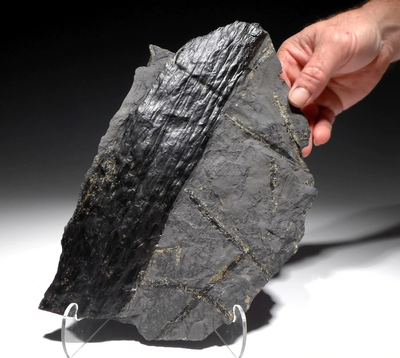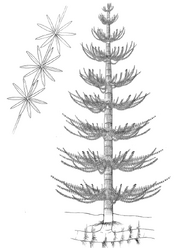
An Upper Carboniferous Calamite Fossil
Calamites, genus of tree-sized, spore-bearing plants that lived during the Carboniferous and Permian periods (about 360 to 250 million years ago). Calamites had a well-defined node-internode architecture similar to modern horsetails, and its branches and leaves emerged in whorls from these nodes. Its upright stems were woody and connected by an underground runner; however, the central part of the stem was hollow, and fossils of Calamites are commonly preserved as casts of this hollow central portion. Calamites grew to 20 metres (about 66 feet) tall, standing mostly along the sandy banks of rivers, and had the ability to sprout vigorously from underground rhizomes when the upper portions of the plant were damaged. The remains of Calamites and other treelike plants from the Carboniferous Period were transformed into the coal used as a source of energy today. A virtually identical plant from the Triassic Period (about 250 to 200 million years ago) is called Neocalamites .
Anatomy[]
The trunks of Calamites had a distinctive segmented, bamboo-like appearance and vertical ribbing. The branches, leaves and cones were all borne in whorls. The leaves were needle-shaped, with up to 25 per whorl.

Reconstruction of Calamite
Their trunks produced secondary xylem, meaning they were made of wood. The vascular cambium of Calamites was unifacial, producing secondary xylem towards the stem center, but not secondary phloem.
The stems of modern horsetails are typically hollow or contain numerous elongated air-filled sacs. Calamites was similar in that its trunk and stems were hollow, like wooden tubes. When these trunks buckled and broke, they could fill with sediment. This is the reason pith casts of the inside of Calamites stems are so common as fossils.